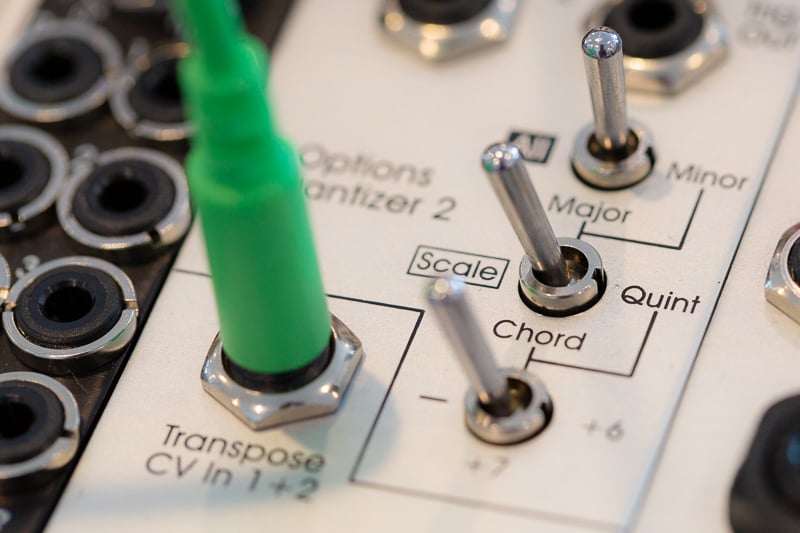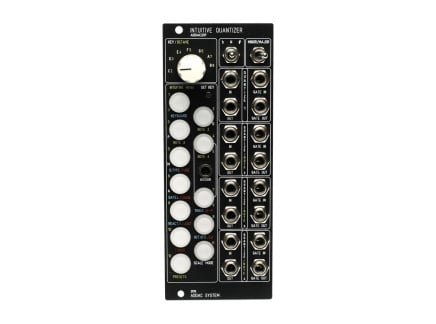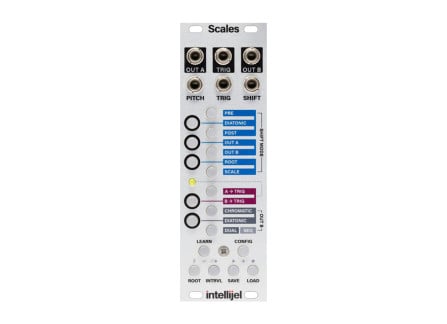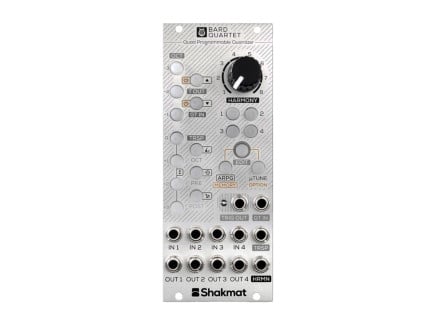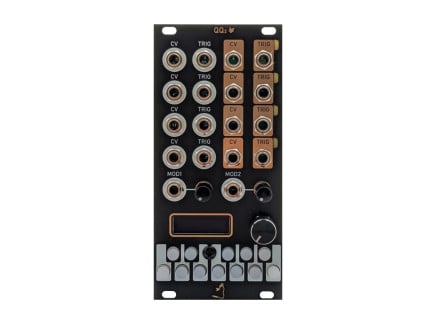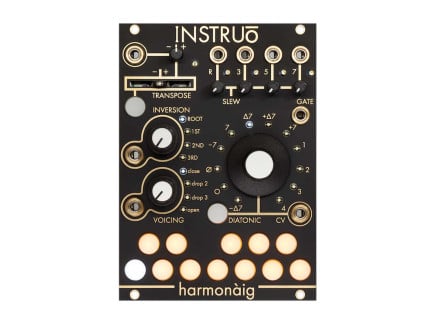A quantizer is a module that takes control voltage signals and constrains them to a particular set of notes in a modular synthesizer. One of its applications is to make sequences of voltages sound more "musical" than sequences of uncorrelated voltage levels.
Quantizers can be thought of as rounding off voltages, the same way that a number with a decimal such as 2.75 can be rounded off to make a whole number such as 3. If a number, or in the case of synthesizers, a voltage level is between two selected numbers, it is either rounded up or down to the nearest whole number. With quantizers, the available "numbers" are voltage levels set by the quantizer's scale. Most typically, these scales are usually 12-TET Western scales, with some quantizers providing a piano-style layout to indicate the available notes.
In 12-TET scales (12-tone equal-tempered scales), an octave is divided up into 12 equal steps. This tuning system is the most common system of scales in the Western world, but many musical styles outside Western and European countries use scales that fall outside or between the notes afforded by 12-TET tuning. These "in-between" intervals are sometimes called microtonal or microintervals, referring to the fact that they are intervals smaller than semitones.
Now, it's important to understand that quantizers aren't pitch shifters: they don't process the sound of an oscillator, but instead process the voltage that is used to define an oscillator's pitch. To better understand how quantizers work in the context of a modular synth, we first need to understand modular synths' most universal tuning standard: 1V/Oct CV: Pitch scaling.
What Does 1V/Oct Mean?
You may have seen oscillators that feature a 1V/Oct input, which is usually where you patch in pitch sequences or control voltages from a keyboard. But what does this mean?
1V/Oct pitch scaling means that 1 volt of signal change at the input correlates to one octave of change in an oscillator's pitch. In the 1V/oct standard, a change of .0833V (1/12th of a volt) will result in a semitone change of pitch, while an increase of 1V will result in an octave change of pitch. Moog popularized the 1V/Oct tuning standard in the 1960s, and this standard was quickly adopted in contemporary instruments by ARP, Serge Modular Music Systems, Oberheim, and other analog synth manufacturers.
When considered relative to voltage, the yielded frequency in 1V/Oct scaling has an exponentially scaled change—as going up or down by an octave doubles or halves the oscillator's frequency. For instance, A4, the A key above the middle C on a keyboard, is 440Hz (by most standards), A5, one octave up, is 880Hz, while A3, one octave down, is 220Hz. In 1V/Oct tuning, these exponentially increasing frequencies can be produced using a linear change of voltage (just by adding 1V increments). Precisely and accurately reproducing this steep exponential curve is one of the difficulties with analog synthesizers, particularly as they age.
Hz/Volt and 1.2V/Oct: Alternate Tuning Schemes in Vintage Synths
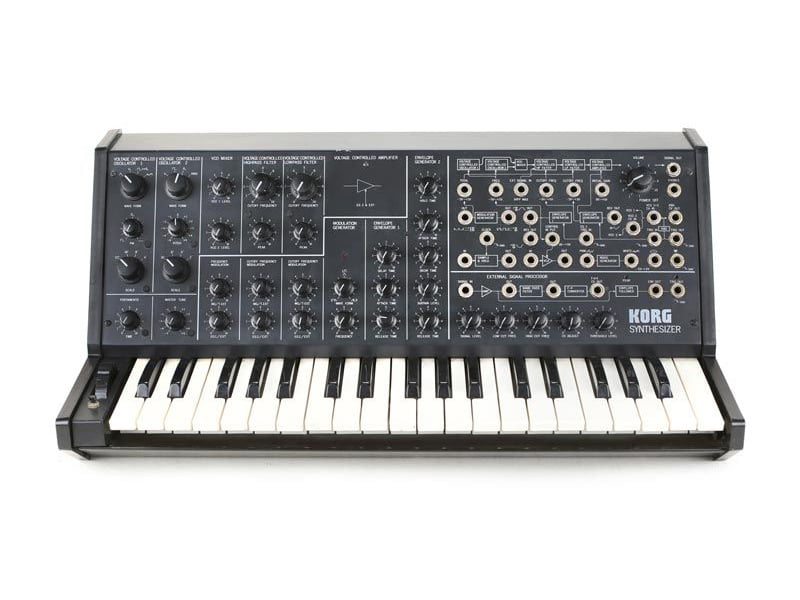
In the 1970s, Korg and Yamaha used an alternative standard called Hz/V or Hertz per Volt. With this system, voltage changes correspond to the number of cycles per second of an oscillator. In this system, doubling of voltage results in an octave of pitch change, so a pitch at 2V is one octave higher than the pitch at 1V and one octave lower than a pitch at 4V. Hz/V doesn't require exponential scaling for accurate pitch tracking and is sometimes used by self-contained synthesizers. In fact, most modern MS-20-inspired instruments still use Hz/Volt pitch scaling.
Buchla's early 100 Series instruments were not terribly concerned with accurate pitch tracking, instead relying on manual tuning of sequencers and touchplate keyboards to create a desired group of pitches. Starting with 200 Series sound sources such as the Music Easel and 259, he introduced an alternative pitch scaling: 1.2V/Oct. In this system, semitone changes in pitch were yielded by 0.1V increments in pitch, which in Buchla's estimation was easier to calculate on-the-fly than 1V/Oct's 0.833V semitone increments. These types of voltage: pitch calculations were important in Buchla's early hybrid instruments, in which a user could use a (somewhat) simple programming language called PATCH to specify exact voltage levels to be sent to analog oscillators. Of course, we say "simple" here with a big grain of salt—take, for instance, the below diagram for the PATCH-IV language, which offers a partial explanation for how to control oscillator parameters (including pitch) from the system's dedicated computer:
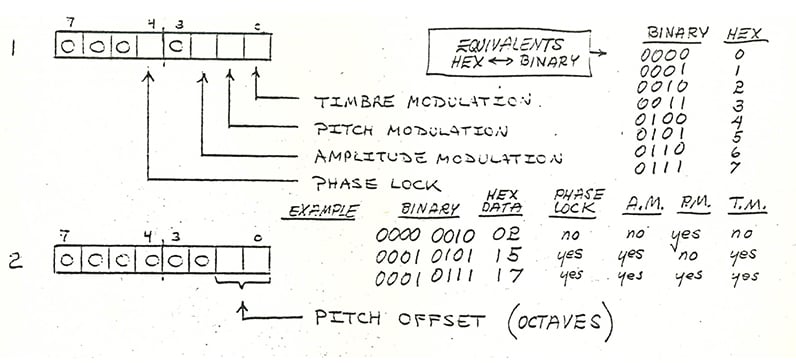
Mid- and late-1970s Buchla systems often adhere to yet another tuning standard—2.4V/Oct. This tuning standard was adopted along with the introduction of Buchla's 300 Series hybrid systems. These instruments paired 200 Series modules with an intricate system of computer control. The 300's 2.4V/Oct standard used a similar form of logic as the 1.2V/Oct system...but it was implemented so that composers could more easily conceptualize the differences in voltage required to produce quarter-tone intervals (0.1V increments yielded a change of a single quarter-tone, whereas 0.2V increments yielded changes of semitones). PATCH-IV, the language used with the 300 Series system, made it relatively easy for composers to experiment with microtonal composition, focusing on allowing larger voltage changes to correspond to smaller changes in pitch (allowing higher resolution for working with alternate tunings). As always, we can trust Buchla to create yet another peculiar and amusing footnote in the greater history of electronic music.
Quantization in Vintage Synthesizers
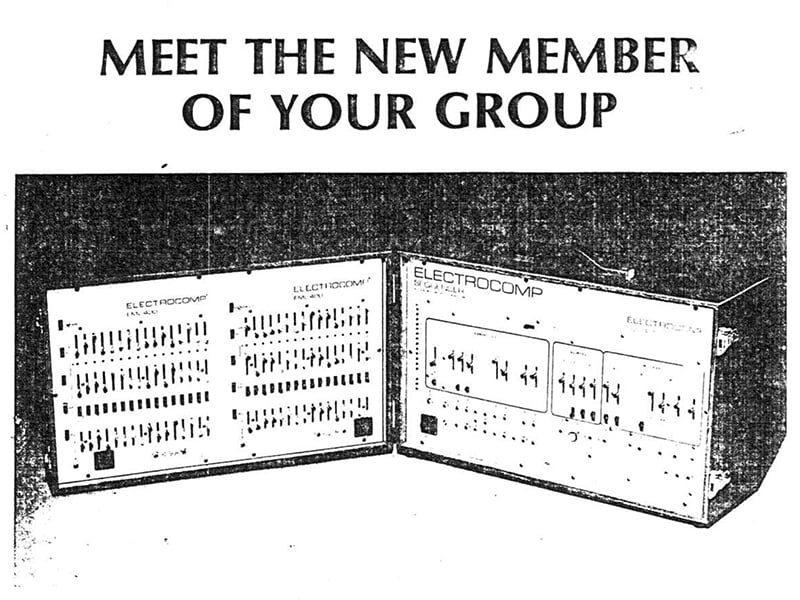
Many should be familiar with digital tools like Autotune, Melodyne, and other sophisticated means of pitch detection and correction. And in a sense, these processes can be seen as similar to quantization in an analog synth. After all, they have the same goal: to take signals and help them conform to traditional "musical" scales. Autotune and Melodyne do this through complex means of sonic analysis, and actually re-pitch recordings or pre-recorded audio. However, quantization in the analog realm has existed well before the advent of digital quantization, and works differently: rather than "pitch shifting" oscillators, for instance, quantization works by processing the signals that control oscillators and snapping them to voltages that conform to specific scales. As seen above, this might mean snapping to the nearest 0.833V (in 1V/Oct tuning), or to the nearest 0.1V (in 1.2V/Oct tuning), or to the nearest 0.2V (in 2.4V/Oct tuning). So, quantizers can accept control signals from sequencers, LFOs, or other modulation signals, and are typically placed in line between a control source and an oscillator.
Some of the earliest modular synth "quantizers" were actually built in to sequencers—such is the case with the EML 400, for instance. The EML 400 was an analog sequencer that featured a digitally controlled quantizer that made tuning the notes in a sequence to melodic scales easy. It even allowed for microtonal scales, letting the user define the steps-per-octave from 5 to 60, far above the standard 12 semitones per octave used by most quantizers. However, it did not allow for external voltages to be introduced into the sequencer and quantized.
 A seriously creepy ad for the ARP 1601.
A seriously creepy ad for the ARP 1601.
The ARP 1601 sequencer was a companion to the 2600 and other ARP synthesizers, released in the 1970s. It could function as two eight-step sequencers, or the two sequencers could be linked into one 16-step sequencer. The onboard quantizer snaps the 0–10V voltage output to the nearest .0833V, quantizing it to a 12-TET semitone. One unique feature is the ability to introduce an external CV into the sequencer. CV signals could be patched in pre or post quantizer, allowing you to add a keyboard's notes for transposition or random voltage source into the sequencer in order to create new and aleatoric sequences. Interestingly, advertisements for the 1601 presented it as an "extra hand" for the keyboardist—which, while not insincere, definitely offer perspective on how musicians might have seen these tools at the time. Not to mention, the way they were advertised was pretty wild—never thought I'd see a sequencer with knuckles and fingernails.
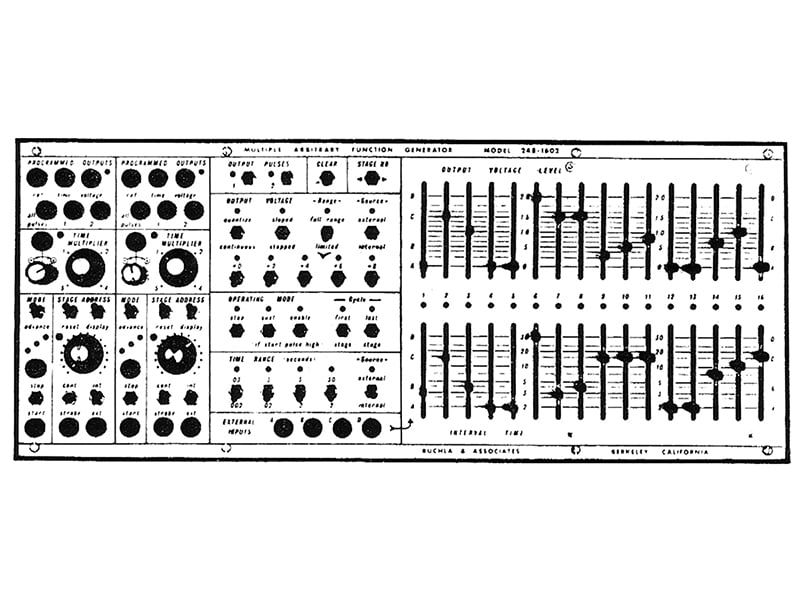
While not precisely a quantizer in the traditional sense, voltage addressable sequencers can function as a non-linear quantizer. A voltage addressable sequencer has, in addition to the clock input, a CV input. The level of this CV signal determines which step in the sequencer is active. Tuning the steps of the sequencer to specific intervals will effectively quantize the incoming voltage to those levels. Interestingly, this approach can be nonlinear: a higher input voltage may or may not result in a proportional voltage level out of the sequencer. Instead, it produces whatever voltage is represented by that step on the sequencer. Early examples of CV addressable sequencers are the Buchla 246 Sequential Voltage Source and the 248 Multiple Arbitrary Function Generator, otherwise known as the MARF. While these early sequencers did not have the kind of quantization we think when we usually think of a quantizer, the basic premise is the same, constraining a voltage to a fixed set of intervals—and even allowing for a level of customization not altogether common elsewhere.
At the end of the 1970s, Serge developed a quantizer for use in their modular system. It had a selection of channels of inputs (the number is based on the Quantizer module used) that would be quantized to a selected scale and then output that quantized voltage. It features both switches and gate inputs to control which equal temperament scale is active. These examples presume that the oscillator that is sequenced is tuned to an E. With neither of the switches active, the output will be a chromatic scale, as noted in the diagram below.
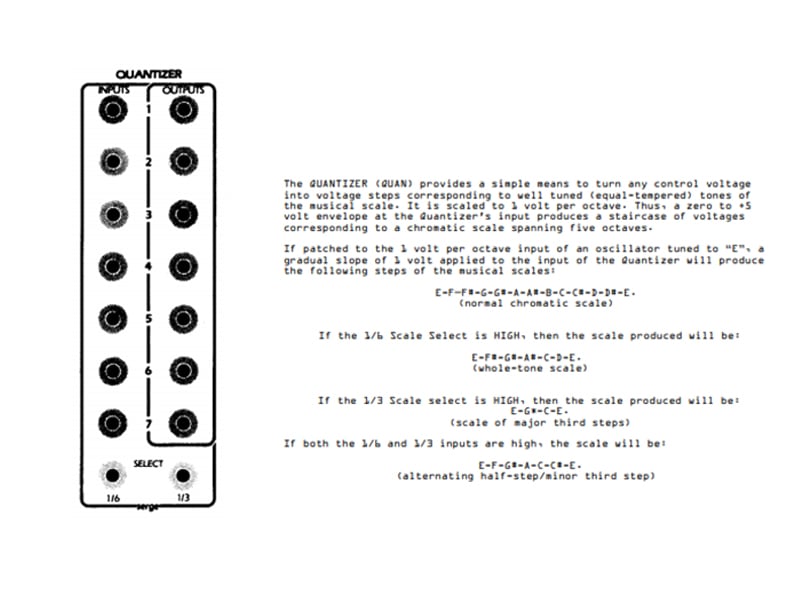
Alternatively, with the 1/3 scale selection high, the scale will be a major third steps. If both switches or gate inputs are high, then the scale will be an alternating half step/minor third step.
The scale select gate inputs respond to incoming signals quickly, allowing for scales to be switched through accurately and rapidly, making new scales that develop over time. Sometimes the Quantizer module was paired with Serge modules such as the Touch Keyboard, known as TKB, or the Sequencer Programmer. The TKB quantizer features four independent channels for use with external control voltages and four channels tied to the ABCD channels on the TKB. STS or Sound Transform System took over Serge in the 1990s and released a well-received panel called ASR/Quan with a VC Timegen clock, /N Com, two analog shift registers, and a six-channel Quantizer. The ASR was one of Serge's modules that suggested pairing with the quantizer in their catalogs and promotional material.
Quantizer Patch Ideas
The most basic and often-used setup for a quantizer is to pair it with a sequencer. In modular synths, most analog (and some digital) sequencers have no built-in quantization of notes. The tuning potentiometers for each step puts out a continuous voltage across the entire range of the control, allowing for finer voltage level adjustments. Taking the sequencer's voltage output into a quantizer constrains the sequencer's steps to a scale set by the quantizer. Changing steps on the fly of an unquantized sequence can lead to potentially unwanted key changes, as the relationship between the notes of the sequencer has changed. Running into a quantizer eliminates this problem. Any changes made to the voltage levels of the sequencer will still fall within the set scale.
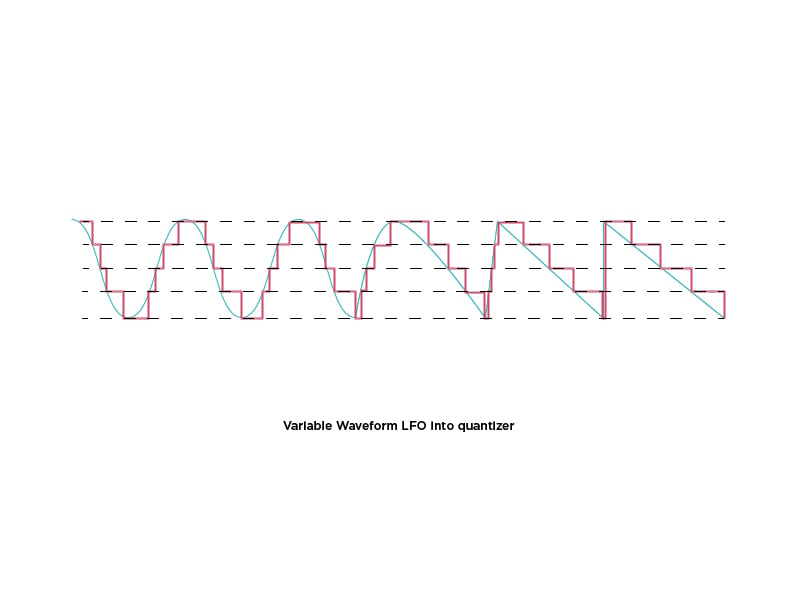
A quantizer can easily be turned into an arpeggiator using an LFO. The LFO will linearly move through the steps of the quantizer, creating a stepped arpeggiated pattern. Changing the speed and waveshape of this LFO will affect the arpeggio in question. Constraining the scale to a smaller set of notes, such as four notes in a scale, will make the LFO driven arpeggio only operate in a small range of possible values and result in a more traditional arpeggio behavior, rather than going through the full range of the scale. Some quantizers will allow you to pick out a small selection of notes instead of being set to whole scales. Attenuating and offsetting the LFO is a great way to dial in specific patterns. A square wave LFO will only jump between two notes, useful for making fifths or octave jumps. A downward sloping sawtooth or upward sloping sawtooth waveforms will suddenly jump from the low point to the high point on the scale or vice versa. As the LFO waveform becomes more complex, it results in new and more intricate arpeggios.
Using a quantizer with a random voltage source will create an evolving and changing pattern constrained to the quantizer's scale. This pairing of random and musical elements can result in tons of happy accidents and may allow you to find new inspiration. Some random modules, such as Marbles from Mutable Instruments and Melodicer from Vermona, have internal quantization that constrains their output to scales, making an external quantizer unnecessary. Some random modules also have a limited number of possible values that they can output, which can be thought of as a form of quantization. This is often the case with shift register-based random sources, such as the Doepfer A-149-1 and Verbos Random Sampling. Both of these modules are based on the Buchla 266 Source of Uncertainty. The quantized random voltage section on both modules have controls for the overall range of possible output values. These have a limited range of outputs but are not precisely tuned to .0833V steps. The outputs are N+1 and 2^N, with N being the overall range of values, from 1 to 6. N+1 has a range of values of N (the panel control) plus one additional. So with the control at 4, 5 values are possible. 2^N is two to the power of the panel control N. With the control at 2 for the 2^N, four values are possible, with N=4, 16 values are possible to be output. The Frap Tools Sapel offers these sorts of outputs, but snaps them to "musical" intervals such as octaves and semitones, making it easy to harness this type of randomness for tonal music-making.
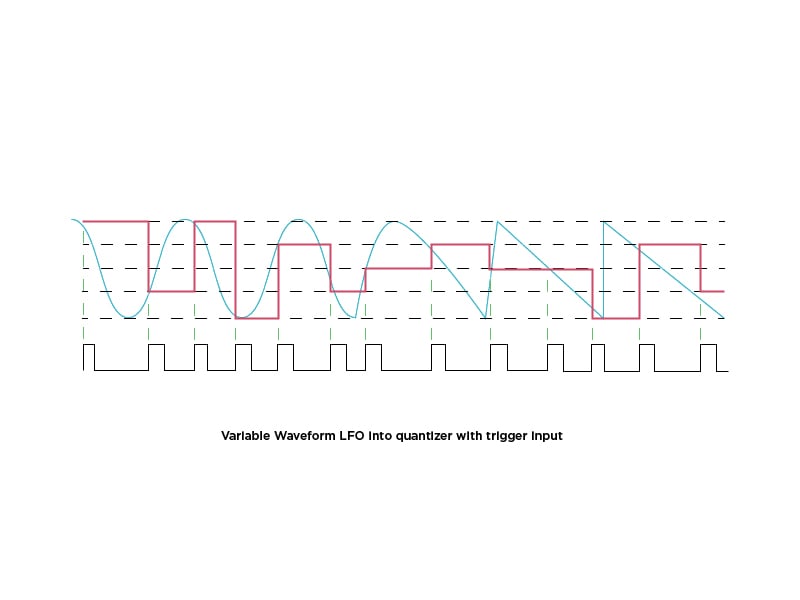
A sample and hold can be used in conjunction with a quantizer, either built-in or external. Route an LFO into a quantizer and then take that quantizer's output into a sample and hold. Intermittently clocking the sample and hold will pick up different notes from the quantizer, instead of continually changing. By running the LFO and clock at different rates, you'll be able to find a whole world of shifting melodic patterns, great for quickly creating interesting generative melodies and harmonies. Some quantizers have a sample and hold already built into them, which causes the quantizer not to change notes until it receives an external gate or trigger signal.
Quantizers in Eurorack Modular Systems
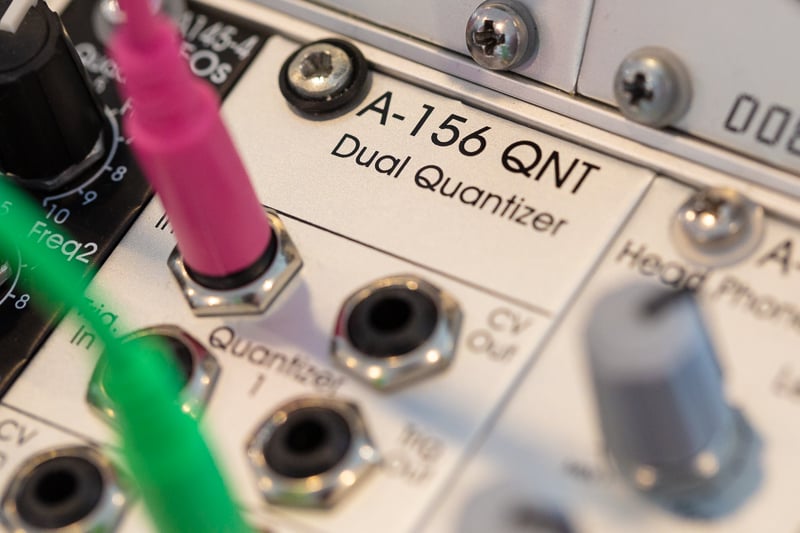
There are, of course, lots of dedicated quantizer modules available in the Eurorack format. The Doepfer A-156 appears on its surface to be a direct descendant of the Serge Quan, providing quantized voltages with a selection of switches to determine the scale. It adds extra options for scales and includes trigger input and output. The trigger input synchronizes the quantization to an external trigger source. The quantizer won't output anything when a cable is patched into that jack until a positive edge is detected, at which point the quantizer looks at the input voltage and outputs a corresponding quantized voltage.
On the other hand, the trigger output sends out a trigger signal whenever a new quantized voltage is reached, useful for firing off envelopes in time with note changes. By default, the top quantizer simply quantized any voltage coming into it to .0833V intervals, making it a chromatic scale with all 12 notes available. However, this can be changed by a jumper to follow the scale selection at quantizer 2. Quantizer 2 has options for major scale, minor scale, major chord, minor chord, fundamental and fifth, and the seventh and sixth in the chord modes.
If you're looking for something with a more modern feature set, Scales from Intellijel is a dual-channel quantizer with an integrated SH-101-style step sequencer. It features a vertical piano-style layout to select the active steps in a scale, with up to 35 scale patterns able to be saved and recalled. A single CV input can be paired with both outputs, allowing for shifted harmonic intervals and counterpoint from one CV signal. The dual-mode allows for both A and B channels to quantize their own CV channels to a common scale. An external modulation signal can be used to shift scales, root notes, or add to the CV signals, pre or post quantization. With the interval control, the A and B channels can be offset from each other, great for related but separate sequences of notes. Not only is Scales a quantizer, but it also doubles as a sequencer, letting users enter up to 128-step long sequences. This can be manually entered using the multi-function buttons and then played back and external quantization of CV signals.
The ADDAC 207 Intuitive Quantizer is a rather deep quantizer used to quantize up to four voltages to a scale. This can be set with the vertical piano-style layout of buttons, or defined using the key, flat/sharp switch, and major/minor switch. Additionally, non-standard scales can also be accessed, including just intonation, Bohlen-Pierce, and several "exotic" scales. In addition to quantizing voltages to 1V/oct standard, it can also constrain voltages to the Buchla standard of 1.2V/oct. The 207 also has a trigger input that acts as a sample and hold. Nothing will pass through until it receives a trigger signal, at which point it will sample the incoming CV signal, constrain it to the scale, and pass it through to the output. This allows you to constrain the quantizer to only output voltages at a specified time, instead of a constant voltage output. For example, you could patch in white noise to the quantizer input and send triggers into the module to randomly pick out notes from the noise without an external sample and hold module.
uTune from Tubbutec is a unique and quite flexible option, pairing a dual-channel quantizer with a MIDI–CV and CV–MIDI interface. Most interestingly, it supports a range of temperaments not constrained to 12-TET scales even when using external MIDI input. It is an incredibly precise microtonal quantizer that supports both CV and MIDI quantization. This makes it a module of choice for many experimental musicians, especially those interested in exploring microtonality and just intonation.
As you know by now, 12-TET equal temperament scales used by most Western musicians are based around equal distribution of notes over an octave—these are not defined with whole-number ratios, but rather an irrational number frequency ratios, done to space the notes throughout the octave equally. In the 12-TET tuning system, perfect ratios such as fifths are not possible due to these irrational number system between the notes in the octave. Tuning systems based on just intonation use whole number ratios in order to create relationships between notes that consist of mathematical ratios instead of equally dividing up notes in an octave. Not only does uTune support just intonation—but a wide range of scales, including non-octave repeating and scales with up to 128 notes. Enter custom scales using cents, fractions, common ratios, or using the Scala tuning format, a now-standard means of experimenting with alternative tuning. From perfect whole number ratio quantization to non-octave repeating, microtonal, and even your standard 12-TET scales, uTune is a versatile quantizer that covers many bases.
Oscillators with Dedicated Quantizers
Some modules also have internal quantizers that can be used instead of external quantizers to create musically related melodies out of continuous control voltage. The Dreadbox Hysteria, for instance, has an optional onboard quantizer that constrains incoming CV to semitones. Where you would usually find the coarse and fine-tune controls on an oscillator, with the quantizer on, Hysteria has an octave and semitone tuning, making getting in tune easy. However, there aren't built-in scales, making it quantize simply to semitones with no masking of "wrong" notes from the output.
The 4ms Ensemble Oscillator is a complex oscillator that straddles the line between complex chords and complex waveshapes. A total of 16 oscillators can be used and spread out from a center frequency, determined by the root knob. It has three quantization modes: 12-TET, Oct, and Free. 12-TET features a selection of equal temperament scales ranging from just octaves to minor triads to two different "bluesy" scales. The Octave scale group accepts any interval, but the notes repeat throughout a selected number of octaves. This includes scales that repeat over 2 or 3 octaves, instead of the standard one-octave repeating scale. These include perfect fifths, Pythagorean just intonation, and 7-TET scales. Free mode is where things get really interesting; these scales have no restrictions for octave behavior or the intervals used. They include Messiaen, Bohlen-Pierce, and Wendy Carlos' Alpha and Beta scales.
One area that the Ensemble Oscillator differs from traditional quantizers is the behavior it displays while changing notes. Instead of a typical stair-stepping behavior associated with many quantizers, the Ensemble Oscillator crossfades between notes, providing a smooth transition from note to note. Up to 16 oscillators can be spread apart from a center root note frequency, creating a complex chord. Not only does the Ensemble Oscillator create complex chords, but it also creates complex waveshapes, and the resulting sound is an interplay of these two elements. The sound sculpting possibilities are profound, with cross FM between the oscillators, three-wave folding algorithms, and three twist or phase shaping algorithms.
Quantizers can come in many forms, and they have a wide range of applications. They can constrain otherwise disparate series of voltages into a range of notes that are organized into a cohesive musical idea. This can be anything from a C major scale to Wendy Carlos's asymmetric microtonal non-octave repeating scales. The range of quantizers available suits any musical style that uses melodic structures, be it equal tempered or experimental, and helps to reign in the often unruly nature of musical instruments based around electricity.

